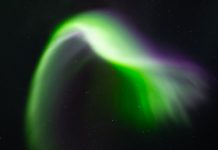Eerie noises associated with especially powerful auroras have been reported since centuries.
Now a team of scientists think they know why.

Witnesses compare the sounds to radio static, like a faint crackling, light rustling, or hissing heard for a few minutes during a strong display describe witnesses.
The mysterious sound is due to charged particles trapped in a layer of the atmosphere that forms during cold nights. These particles rapidly discharge when bursts of material from the sun slam into Earth, producing clapping sounds and other noises.

The aurora eerie music
Previously, one of the leading theories for aurora noise suggested that tree needles or pine cones may be involved. During geomagnetic storms, the atmosphere can hold abnormally high electric fields, creating a difference in charge between the air and objects on the ground.
Anything pointy, like leaves and pine cones, would offer the perfect surface for electricity to discharge, like a static shock jumping from a doorknob to your finger, and that might set off an audible cracking sound.
But back in 2012, scientists showed that auroral sounds were emanating from above the treetops – 230 feet (70 meters) above Earth’s surface – during the times of the most intense displays.
It seems now that the key to the crackle mystery is something called an inversion layer, a region of the atmosphere where the air temperature increases with altitude instead of experiencing the usual decrease.
This inversion layer then acts like a lid, trapping negative electrical charge in the region below it and positive charge in the air above. When a geomagnetic storm hits Earth, the lid breaks and the charge is released, creating the weird sounds.
Auroral sound is not a folkloric phenomenon anymore. It is now based on a physical process that provides a good explanation.












